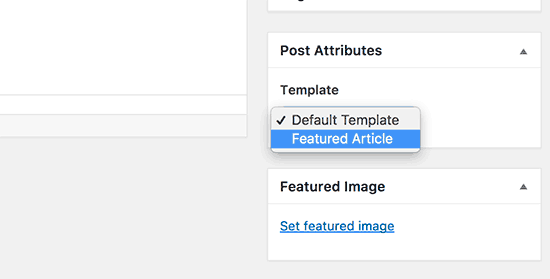如何装修网站-网站自定义模版
一键生成网站-网站补充工具栏
2018年9月28日网站安全问题-网站阻止IP地址
2018年9月28日如何装修网站-网站自定义模版,您想在WordPress中创建自定义单个帖子模板吗?自定义单个帖子模板允许您轻松为帖子选择不同的模板。在本文中,我们将向您展示如何在WordPress中轻松创建自定义单个帖子模板。
 注意:本教程要求您编辑WordPress主题文件。如果您之前没有这样做,那么请查看我们的教程,了解如何在WordPress中复制和粘贴代码。
注意:本教程要求您编辑WordPress主题文件。如果您之前没有这样做,那么请查看我们的教程,了解如何在WordPress中复制和粘贴代码。
 话虽如此,让我们来看看如何在WordPress中轻松创建自定义单个帖子模板。
话虽如此,让我们来看看如何在WordPress中轻松创建自定义单个帖子模板。
此代码定义了一个名为“特色文章”的新模板,并使其可用于帖子,页面和产品帖子类型。
您可以将此文件另存为 您将看到那里列出的“特色文章”自定义模板。
现在你的模板基本上是空的,所以选择它只会显示一个白色的屏幕。
我们解决这个问题。
最简单的方法是从主题的single.php文件中复制代码并将其用作起点。
打开single.php文件,然后复制该
您将看到那里列出的“特色文章”自定义模板。
现在你的模板基本上是空的,所以选择它只会显示一个白色的屏幕。
我们解决这个问题。
最简单的方法是从主题的single.php文件中复制代码并将其用作起点。
打开single.php文件,然后复制该
此代码首先检查WordPress是否正在请求单个帖子。如果是,则告诉WordPress在WordPress主题的/ single /文件夹中查找模板。
现在您需要添加此代码定义的模板文件。
使用cPanel中的FTP客户端或文件管理器连接到WordPress站点,然后转到/ wp-content / themes / your-theme-folder /。
在当前主题文件夹中,您需要创建一个名为“single”的新文件夹。
现在您需要打开此文件夹并在其中创建一个新文件。来吧,将此文件命名为single-cat- {category-slug}。将{category-slug}替换为您的实际类别slug。
例如,如果您有一个名为“新闻”的类别,那么您将创建single-cat-news.php文件。如何装修网站如果您有一个名为“旅行提示”的类别,则创建一个模板single-cat-travel-tips.php,依此类推。

接下来,您需要使用cPanel中的FTP或文件管理器连接到您的网站,然后转到/ wp-content / themes / your-theme-folder /。
如果您还没有在其中创建一个名为/ single /的文件夹,那么现在让我们继续创建它。
在此文件夹中,您需要使用模板名称中作者的用户名创建模板。例如,single-author-johnsmith.php。
此模板将为空,因此您可以复制粘贴主题的single.php模板的内容并将其用作起点。
您现在可以访问您的网站以查看特定作者创建的帖子。它现在将使用您创建的模板。
目前为止就这样了。
我们希望本文能帮助您学习如何在WordPress中创建自定义单个帖子模板。您可能还想查看WordPress functions.php文件的非常有用的技巧列表。
 注意:本教程要求您编辑WordPress主题文件。如果您之前没有这样做,那么请查看我们的教程,了解如何在WordPress中复制和粘贴代码。
注意:本教程要求您编辑WordPress主题文件。如果您之前没有这样做,那么请查看我们的教程,了解如何在WordPress中复制和粘贴代码。
什么时候需要自定义单个帖子模板?
有时您可能想要对您网站上的某些帖子有不同的外观和感觉。例如,您可能希望为特定类别中的精选文章或故事使用不同的模板。 这是您需要在WordPress中创建自定义单个帖子模板的地方。 这非常类似于创建自定义页面模板。您可以从帖子编辑屏幕中选择模板。 话虽如此,让我们来看看如何在WordPress中轻松创建自定义单个帖子模板。
话虽如此,让我们来看看如何在WordPress中轻松创建自定义单个帖子模板。
在WordPress中创建自定义单个帖子模板
首先,您需要在计算机上打开纯文本编辑器,如记事本,并在其中粘贴以下代码:|
1
2
3
4
五
6
7 |
<?php/* * Template Name: Featured Article * Template Post Type: post, page, product */ get_header(); ?> |
wpb-single-post.php桌面。
接下来,您需要使用FTP客户端将其上传到当前的WordPress主题文件夹。
之后,您可以登录您的WordPress管理区域并创建或编辑帖子。在帖子编辑屏幕上向下滚动一下,您会注意到新的“帖子属性”元框,其中包含选择模板的选项。
 您将看到那里列出的“特色文章”自定义模板。
现在你的模板基本上是空的,所以选择它只会显示一个白色的屏幕。
我们解决这个问题。
最简单的方法是从主题的single.php文件中复制代码并将其用作起点。
打开single.php文件,然后复制该
您将看到那里列出的“特色文章”自定义模板。
现在你的模板基本上是空的,所以选择它只会显示一个白色的屏幕。
我们解决这个问题。
最简单的方法是从主题的single.php文件中复制代码并将其用作起点。
打开single.php文件,然后复制该get_header()行之后的所有内容。
将此代码粘贴到最后的wpb-single-post.php文件中。现在,您可以保存此文件并将其上传回服务器。
但是,这与您当前的单个帖子模板完全相同。您现在可以开始更改自定义单个帖子模板。
您可以添加自己的自定义CSS类,删除侧边栏,创建全宽模板或任何您想要的内容。
基于类别创建自定义单个帖子模板
想要使用基于类别的自定义单个帖子模板吗?例如,旅行类别中的帖子可以具有与摄影中的帖子不同的布局。 这是你如何做到这一点。 首先,您需要将此代码添加到主题的functions.php文件或特定于站点的插件中。|
1
2
3
4
五
6
7
8
9
10
11
12
13
14
15
16
17
18
19
20
21
22
23
24
25
26
27
28
29
三十 |
/** Define a constant path to our single template folder*/define(SINGLE_PATH, TEMPLATEPATH . '/single');/*** Filter the single_template with our custom function*/add_filter('single_template', 'my_single_template');/*** Single template function which will choose our template*/function my_single_template($single) {global $wp_query, $post;/*** Checks for single template by category* Check by category slug and ID*/foreach((array)get_the_category() as $cat) :if(file_exists(SINGLE_PATH . '/single-cat-' . $cat->slug . '.php'))return SINGLE_PATH . '/single-cat-' . $cat->slug . '.php';elseif(file_exists(SINGLE_PATH . '/single-cat-' . $cat->term_id . '.php'))return SINGLE_PATH . '/single-cat-' . $cat->term_id . '.php';endforeach;} |

如何装修网站
现在这些模板文件将完全为空。作为起点,您可以从主题文件夹中复制single.php文件的内容,如何装修网站并将其粘贴到每个模板中。 您现在可以编辑这些模板以进行所需的更改。 完成后,您可以访问您的网站并查看帖子。它将使用您为此帖子归档的类别创建的模板。 现在让我们假设您有两个类别的新闻和旅行提示。WordPress将自动显示“新闻”的模板,如何装修网站因为它首先按字母顺序显示。 另一方面,如果您在某个类别中提交了帖子但没有为该类别创建模板,那么WordPress将回退到您主题的默认single.php模板。为特定作者创建自定义单个帖子模板
假设您希望特定作者撰写的帖子在您的网站上看起来与众不同。你可以使用我们为类别显示的相同技术来做到这一点。 首先,您需要将此代码添加到主题的functions.php文件或特定于站点的插件中。|
1
2
3
4
五
6
7
8
9
10
11
12
13
14
15
16
17
18
19
20
21
22
23
24
25
26
27
28
29 |
/*** Define a constant path to our single template folder*/define(SINGLE_PATH, TEMPLATEPATH . '/single');/*** Filter the single_template with our custom function*/add_filter('single_template', 'my_single_author_template');/*** Single template function which will choose our template*/function my_single_author_template($single) {global $wp_query, $post;/*** Checks for single template by author* Check by user nicename and ID*/$curauth = get_userdata($wp_query->post->post_author);if(file_exists(SINGLE_PATH . '/single-author-' . $curauth->user_nicename . '.php'))return SINGLE_PATH . '/single-author-' . $curauth->user_nicename . '.php';elseif(file_exists(SINGLE_PATH . '/single-author-' . $curauth->ID . '.php'))return SINGLE_PATH . '/single-author-' . $curauth->ID . '.php';} |




